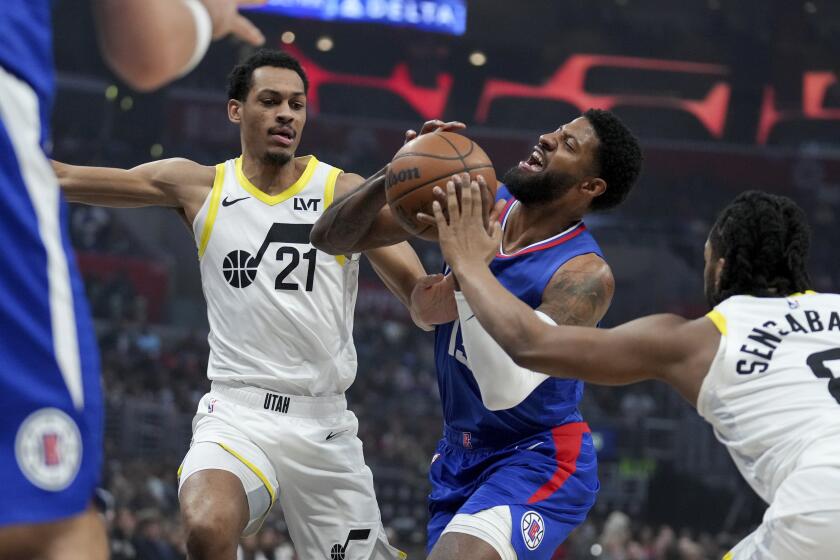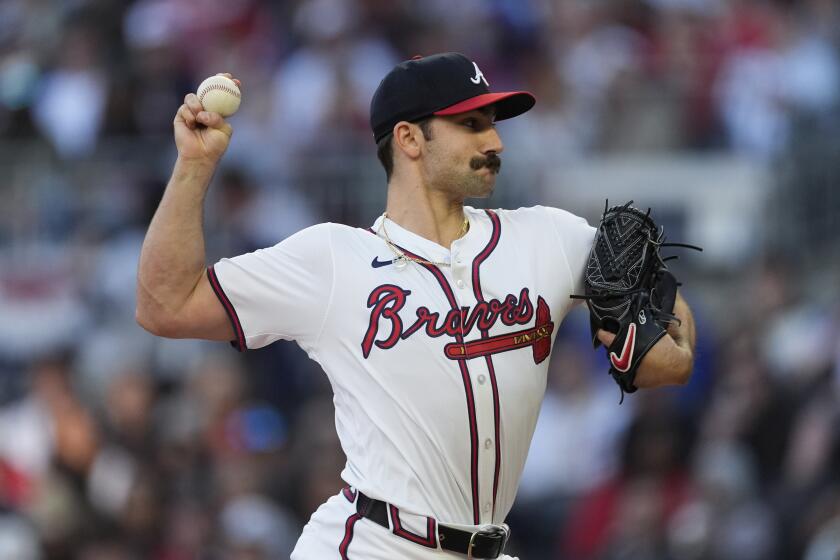Where does L.T. rank among Hall of Famers?
Do you miss football?
LaDainian Tomlinson answered the question without a pause in November.
“No,” he said. “It’s time not to get hit anymore.”
When you are a running back, whoever you are and whatever the football era, you will get hit. If you’re good enough to command more handoffs, as Tomlinson did, the hits will accumulate.
NFL legislators have scaled back the brutality of football for quarterbacks and wide receivers, though of course they, too, still can get their bones broken, ligaments torn and brains concussed.
Running backs remained fair game, even after the League adopted profit-driven rules that increasingly sheltered the men who threw and caught touchdown passes.
So, behold Tomlinson.
Now 37, the former Chargers mainstay was a standout running back for nearly a decade.
Football writers affirmed his career Saturday when they rubber-stamped Tomlinson for the Pro Football Hall of Fame on the first chance they got.
“He could run, he could catch, he could block. Did it all, and that’s what you want,” longtime Hall voter Rick Gosselin told San Diego’s 1090-AM this week, “You want to put complete players in Canton. He’s a complete player.
“He’s a first-ballot Hall of Famer if there ever was one.”
And because he was a running back, projecting Tomlinson’s brilliance to another era involves almost no guesswork.
Much like when Eric Dickerson, Franco Harris and Jim Brown were taking handoffs in their era’s version of “tag, you’re it,” Tomlinson drew only threadbare protection from the League’s rules.
So, the 21st-century defenders who were constrained in their attacks on passers and pass-catchers were free to slam helmet-first into Tomlinson, or ram into his knees, or “horse-collar” him around the neck.
That is, if they could draw a bead on him.
As for the defenders who chased him, they were faster/bigger/stronger than in others eras.
Tomlinson was up to the challenge.
Deploying joystick maneuvers, including his famous “jump cut,” he averted body blows that dropped less-agile running backs in their tracks.
He was, at 221 pounds, a sledgehammer himself. Built low to the ground, the 5-foot-10¼ back had a knack for crow-barring at the point of contact, allowing him to win the collisions and advance the ball.
He was both quick and fast.
The Chargers worked him very hard, loading him up with handoffs and pass catches at extraordinary rates.
Yet he continued to run for touchdowns, catch passes, block blitzers and even throw for points.
Consider the quarterbacks of today, including the deft passers who will square off today in the 51st Super Bowl.
The trade they ply is different in one fundamental aspect from the football played by the likes of Hall of Fame quarterbacks such as Johnny Unitas, Terry Bradshaw and Roger Staubach.
Because the yellow flag will fly, defenders cannot hit them low or high; cannot drive them into the ground; or clobber them a full beat after the ball is thrown; or, should they slide, hit them at all in the open field.
How would Tom Brady, tough but slight and far from fleet, have responded to the maulings of different eras, when it was perfectly legal for defenders to club quarterbacks in the head and wallop them in the knees as they released the pass?
It wasn’t all brute football when Tomlinson played.
The pass-friendly climate, coupled with his rare agility and sure hands, was a boon to his body and his career.
Defenders couldn’t attack Tomlinson with singular force, because he was just as liable to dart away and pluck a pass.
In his third season, in 2003, he collected 100 passes, most of them from Drew Brees, who will join him in Canton someday.
Contemplating the running backs who’ve pulled on the Hall’s gaudy yellow sports jackets, the completeness of performance elevated Tomlinson in the view of seasoned football observers.
Tomlinson amassed impressive statistics while excelling at a game that placed an increasing premium on versatility.
He is third all-time in touchdowns, fifth in career rushing yards and fifth in yards from scrimmage.
He is the 14th running back of the modern era to gain election on his first ballot. The others were, in alphabetical order, Marcus Allen, Brown, Earl Campbell, Dickerson, Tony Dorsett, Marshall Faulk, Harris, Hugh McElhenny, Walter Payton, Barry Sanders, Gale Sayers, O.J. Simpson and Emmitt Smith.
So, among these greats, where does Tomlinson stand?
I rate him in the top-10, somewhere between six and 10.
Brown tops the list. He made his Cleveland Browns opponents look like children.
Next comes Payton, the Chicago Bears great. Like a prize fighter, he wore down his opponents.
Barry Sanders assumes the third spot. Tackling Sanders, whom the Detroit Lions largely failed after drafting him, was like tackling smoke.
Marshall Faulk, who’s fourth, had this in common with Tomlinson: they were lethal receiving backs who moved mid-career into a pass-proficient, Don Coryell system.
Both men gained 4.3 yards per carry. San Diego State alum Faulk may have become a Pro Bowl receiver, had he desired the role. He performed in two Super Bowls with the St. Louis Rams, winning one.
San Diego product Marcus Allen rounds out the top-5.
A Super Bowl MVP with the Oakland Raiders, he was a triple threat: a rusher who won inside or outside; a pass-catcher comparable to many receivers; and a ferocious lead blocker or pass protector.
The lithe Allen was good for 4.1 yards per carry and averaged 9.2 yards per catch, better even than Faulk (9.0) and L.T. (7.6).
Strong cases can be made for several others to join the top-5.
Tomlinson, though, gets the nod over his childhood favorite Smith, a fellow Texan. The difference was blocking, as Smith ran behind Dallas Cowboys lines that rag-dolled opponents.
How good was Sayers, the Bears legend, before a knee injury reduced him?
His yards per carry were 5.2, 5.4, 4.7 and 6.2 through four seasons; in 91 kickoff returns, he averaged a stupefying 30.6 yards per try; his highlight reels were poetry.
The mists of time should not obscure that Dickerson made the Los Angeles Rams Super Bowl contenders absent top-shelf quarterbacking. In 1983 he rushed for 1,808 yards — still a rookie record — on 4.9 per carry and caught 51 passes. Still standing is the league record of 2,105 rushing yards he set in 1984.
Simpson impelled America to watch the mediocre, run-happy Buffalo Bills. He paced at 4.7 yards per carry; in a run-dominant era; his season record of 2,003 rushing yards lasted until Dickerson; because of his body control, soft hands and what is today called “elite” speed, it is easy to picture the 6-2 Simpson as a “No. 1” receiver in today’s game.
Tomlinson, having weathered the barrage, joins this collection of football greats.
Tom.Krasovic@SDUnionTribune.com; Twitter: SDUTKrasovic
Go deeper inside the Padres
Get our free Padres Daily newsletter, free to your inbox every day of the season.
You may occasionally receive promotional content from the San Diego Union-Tribune.










